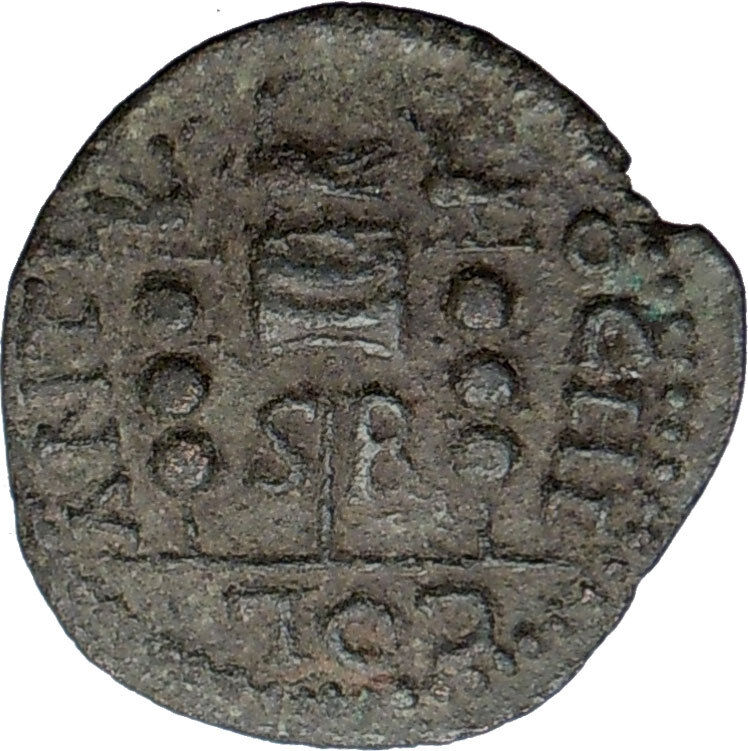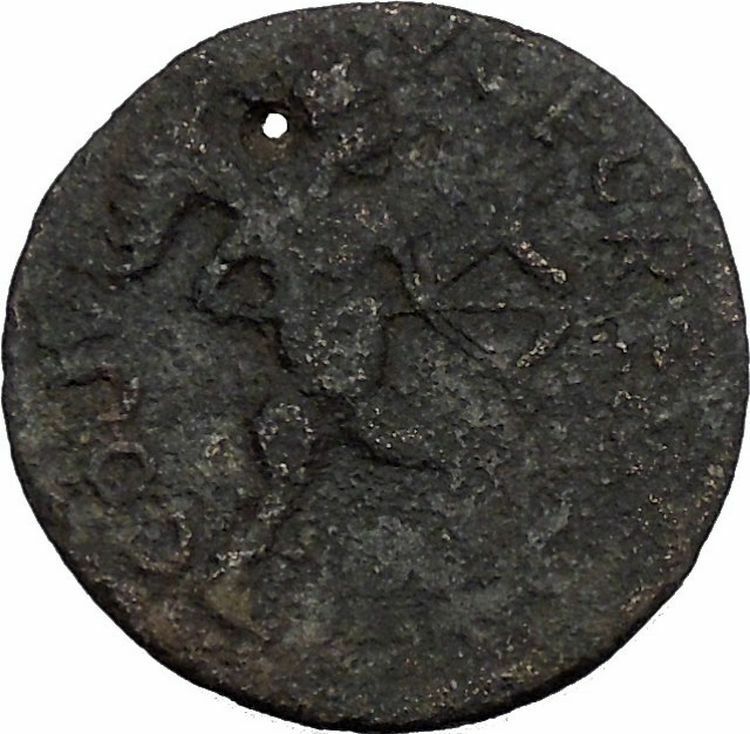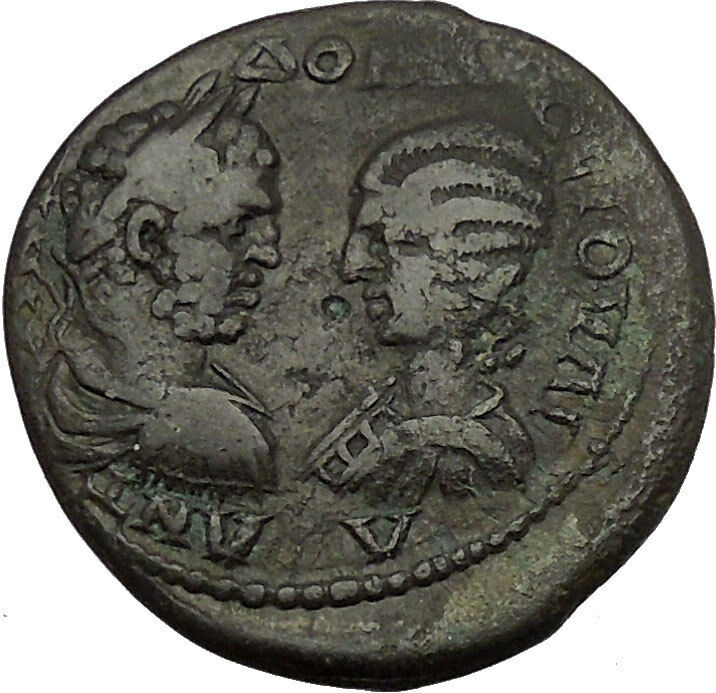|
Trebonianus Gallus – Roman Emperor: 251-253 A.D. –
Bronze 26mm (12.28 grams) Struck at the Roman colonial city of Viminacium
in the province of Moesia Superior 251 – 252 A.D.
Reference: Varbanov 195.
IMP C VIBIO TREBON GALLO AVG Laureate draped bust right.
P M S COL VIM, Moesia standing facing between lion & bull, AN XII (year AD
251/252) in ex.
*
Numismatic Note: The bull and the lion represent the seventh Claudian legion
stationed at the city.
You are bidding on the exact item pictured,
provided with a Certificate of Authenticity and Lifetime Guarantee of
Authenticity.
Legio septima Claudia Pia Fidelis (Seventh Claudian
Legion) was a
Roman legion
. Its emblem, as well as of all
Caesar’s legions, was the bull, together with the lion. The 7th,
along with the
6th
,
8th
&
9th
were all founded by Pompey in Spain in 65
BC. They were ordered to
Cisalpine Gaul
around 58 BC by
Julius Caesar
, and marched with him throughout
the entire Gallic Wars.
Legio VII was one of the two legions used in
Caesar’s invasions of Britain
, and played a
crucial role in The
Battle of Pharsalus
in 48 BC, and it existed at
least until the end of the 4th century, guarding middle
Danube
.
Tiberius Claudius Maximus
the Roman soldier who
brought the head of
Decebalus
to emperor
Trajan
was serving in Legio VII Claudia.
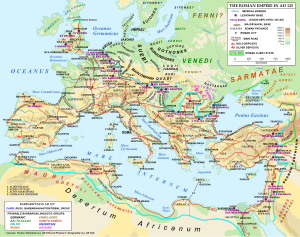
Map of the Roman empire in AD 125, under emperor
HadrianLegio VII Claudia, stationed on
the river
Danube
at
Viminacium
(Kostolac, Serbia), in
Moesia Superior
province, from AD
58 until the 4th century
Viminacium (VIMINACIVM) was a major city (provincial
capital) and military camp of the
Roman
province of
Moesia
(today’s
Serbia
), and the capital of
Moesia Superior
. The site is located 12 km
from the modern town of
Kostolac
in Eastern Serbia. The city dates back
to the 1st century AD, and at its peak it is believed to have had 40.000
inhabitants, making it one of the biggest cities of that time. It lies on the
Roman road
Via Militaris
. Viminacium was devastated by
Huns in the 5th century, but was later rebuilt by
Justinian
. It was completely destroyed with the
arrival
of
Slavs
in the 6th century. Today, the
archeological site occupies a total of 450 hectares, and contains remains of
temples, streets, squares, amphitheatres, palaces, hippodromes and Roman baths.
History

A XXV the scene of the
Trajan’s Column
, which may have
been accounted for “headquarters” of the Roman Emperor: Viminacium.
The remains of Viminacium, the capital of the Roman province of
Moesia Superior
, are located on territories of
the villages of Stari Kostolac and Drmno, about 12 km from the town of
Kostolac
and about 90 miles southeast of
Belgrade
. Viminacium was one of the most
important Roman cities and military camps in the period from 1st to 4th
centuries. Its exceptional strategic importance was reflected both in the
defense of the northern border of the Roman empire and in turn of communications
and commercial transactions. No less appealing to the Romans was the hinterland
of the Mlava
river valley, which is rich in ore and
grains. In Roman times, the town on the northern side of relying directly on the
branch of the Danube
, while the western side, touching the
walls Mlava rivers. Only in the later period, Viminacium spread to the left bank
of Mlava. Thanks to the location, land and waterways, Viminacium represented one
of those areas where the encounter of cultures between East and West was
inevitable. Although these roads were the primary military and strategic
function, they are taking place throughout antiquity very lively traffic and
certainly contributed to the very Viminacium become prosperous and an important
trading and business headquarters. In Viminacium,
Roman legion VII Claudia
was stationed, and a
nearby civilian settlement emerged from the military camp. In 117 during the
reign of Hadrian
it received city status. In the camp,
6.000 soldiers were stationed, and 30-40.000 lived nearby. In the first half of
the 3rd century the city was in full development, as evidenced by the fact that
at that time it acquired the status of a Roman colony, and the right to coin
local money. Here, in 211,
Septimius Severus
was proclaimed emperor by his
son Caracalla
. In the mausoleum and the excavated
tombs, the Roman emperor
Hostilian
, who died in 251, was buried.
A legion may have been stationed here as early as Augustus (27 BC-14 AD). In
33/34 AD a road was built, linking Viminacium and
Ratiaria
.
Claudius
(41-54) garrisoned Viminacium,
Oescus
and
Novae
as camps for the Moesian legions.
The first legion attested at Viminacium was the VII Claudia that came from
Dalmatia in 52 AD .
Emperor Trajan
(98-117) was headquartered here
during the
Dacian Wars
. It became a colonia with
minting privilege in 239 AD during the rule of
Gordian III
(238-244) and housed the Legion VII
and Legion IV.
Emperor Hostilian
was the son of the emperor
Decius
, who was killed in the ambush near the
ancient city of Abrutus located in present day Bulgaria. According to the old
manuscript, emperor Hostilian and his mother came to Viminacium to supervise the
organization of defense of northern borders, but both of them died of the
plague. Because of the distance and the fear of spreading the plague, he was
buried with all honors in Viminacium
Viminacium was the provincial capital of
Moesia Superior
. In the late spring of 293-294,
Diocletian
journeyed through his realm and he
re-organized Viminacium as the capital of the new province of Moesia Superior
Margensis. He registered that the people wrote in Latin, as opposed to Greek
in the southern provinces. Viminacium was the base camp of
ClaudiaLegio VII
,
and hosted for some time the
Flavia FelixIIII
.
It had a Roman amphitheatre with room for 12,000 people.
In 382 the city was the meeting place between
Theodosius
and
Gratian
amidst the
Gothic Wars
.
Viminacium was destroyed in 441 by the
Attila the Hun
, but rebuilt by
Justinian I
. During
Maurice’s Balkan campaigns
, Viminacium saw
destruction by the
Avars
in 582 and a
crushing defeat
of Avar forces on the northern
Danube bank in 599, destroying Avar reputation for invincibility.[3]
Location and
excavation

Valerian
AD 253-260. AR
Antoninianus. Viminacium mint. 1st emission, 1st phase, AD 253.
Viminacium is located in
Stari Kostolac
(Old
Kostolac
) a
Serbian
town on the
Danube
river, east of
Belgrade
. Viminacium is the location of the
first archaeological excavation in Serbia, which started in 1882, by
Mihailo Valtrović
, an architect by profession
and the first professor of archeology at the college in
Belgrade
. The only help he received was from 12
prisoners, because the state did not have enough resources to provide him with a
better work force. His research was continued by
Miloje Vasić
, in the 1970s[clarification
needed]. It has intensified in the last ten years in
the area of the Roman city of the Roman legionary camps and cemeteries. Many
studies suggest that the military camp at Viminacium had a rectangular plan,
measuring 442 x 385 meters, and that is not far from its western wall of
civilian settlement in an area of approximately 72 acres. Legionary camp in
Viminacium is now in a layer of arable land, so that wealth Viminacium easily
accessible to researchers, but, unfortunately, and the robbers.The National
Museum in Belgrade
and
Požarevac
kept some 40,000 items found in
Viminacium, of which over 700 made of gold and silver. Among them are many
objects that represent the European and world rarities invaluable.
It has been discovered and more than 13,500 graves. Tombstones and sarcophagi
are often decorated with relief representations of scenes from mythology or
daily life. We have found numerous grave masonry construction. Especially
interesting are the frescoes of the 4th-century tombs.
Fresco
with the notion of young women in
artistic value of the extreme range of late antique art. During the excavation,
an amphitheater, which with its 12,000 seats was one of the largest in the
Balkans
.
Gaius
Vibius Trebonianus Gallus (206 – August, 253), was
Roman
Emperor
from 251 to 253, in a joint rule with his son
Volusianus
.
Gallus was born in Italy, in a family with respected ancestry
of
Etruscan
senatorial
background. He had two children in his marriage with
Afinia Gemina Baebiana
: Gaius Vibius Volusianus, later Emperor, and a
daughter, Vibia Galla. His early career was a typical
cursus honorum
, with several appointments, both political and military.
He was suffect consul
and in 250 was nominated governor of the
Roman province
of
Moesia Superior
,
an appointment that showed the confidence of emperor
Trajan Decius
in him. In Moesia, Gallus was a key figure in repelling the
frequent invasion attacks by the
Gothic
tribes of
the Danube
and
became popular with the army, catered to during his brief Imperial rule by his
official image: military haircut, gladiatorial physique, intimidating stance (illustration,
left).[1]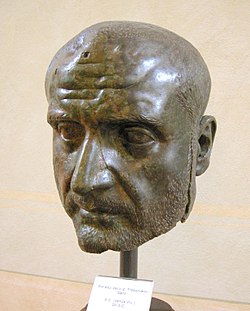
In June 251, Decius and his co-emperor and son
Herennius Etruscus
died in the
Battle of Abrittus
, at the hands of the Goths they were supposed to punish
for raids into the empire, largely owing to the failure of Gallus to attack
aggressively. When the army heard the news, the soldiers proclaimed Gallus
emperor, despite
Hostilian
,
Decius’ surviving son, ascending the imperial throne in Rome. Gallus did not
back down from his intention to become emperor, but accepted Hostilian as
co-emperor, perhaps to avoid the damage of another civil war. While Gallus
marched on Rome, an outbreak of
plague
struck the city and killed young Hostilian. With absolute power now
in his hands, Gallus nominated his son Volusianus co-emperor.
Eager to show himself competent and gain popularity with the
citizens, Gallus swiftly dealt with the epidemic, providing burial for the
victims. Gallus is often accused of persecuting the
Christians
, but the only solid evidence of this allegation is the
imprisoning of
Pope Cornelius
in 252.
Like his predecessors, Gallus did not have an easy reign. In
the East, Persian Emperor
Shapur I
invaded and conquered the province of
Syria
, without any response from Rome. On the Danube, the Gothic tribes were
once again on the loose, despite the peace treaty signed in 251. The army was
not long pleased with the emperor, and when
Aemilianus
,
governor of Moesia Superior and Pannonia, took the initiative of battle and
defeated the Goths, the soldiers proclaimed him emperor. With a
usurper
threatening the throne, Gallus prepared for a fight. He recalled
several legions
and ordered reinforcements to return to Rome from the
Rhine
frontier.
Despite these dispositions, Aemilianus marched onto Italy ready to fight for his
claim. Gallus did not have the chance to face him in battle: he and
Volusianus
were murdered by their own troops in August 253, in
Interamna (modern
Terni)
.

Bronze of Gallus dating from the time of his reign as
Roman Emperor, the only surviving near-complete full-size 3rd century Roman
bronze (Metropolitan
Museum of Art)
|










